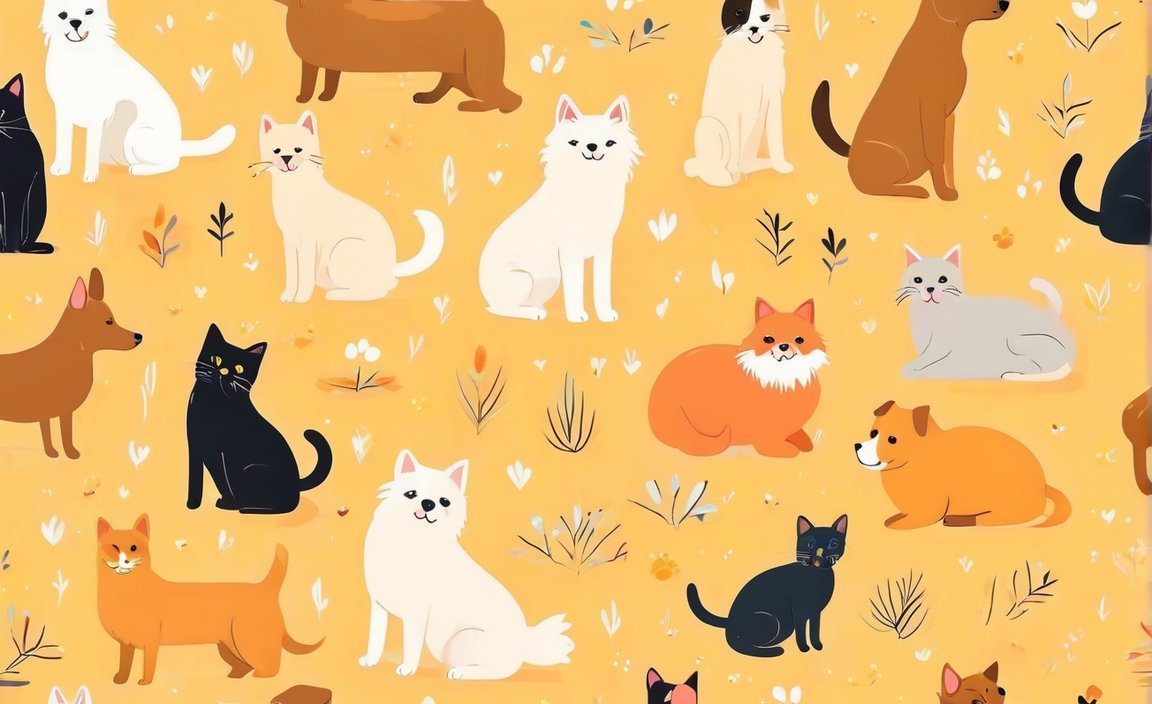Welcome to “Fascinating Facts: 10 Insights into Dogs and Cats,” where we delve into the quirky and captivating world of our furry companions. In this article, we’ll uncover a treasure trove of intriguing knowledge about dogs and cats, shedding light on their fascinating behaviors, remarkable abilities, and unique characteristics. From exploring their uncanny senses to unraveling the mysteries behind their adorable antics, get ready to embark on a journey that unveils the secrets and wonders of these beloved pets.

Key Takeaways:
- Cats spend around 70% of their lives sleeping.
- Dogs often resemble their owners in appearance.
- Domestic cats share approximately 95% of their genetic makeup with lions.
- Dogs are capable of falling in love.
- Many cats are lactose intolerant and should avoid dairy products.
- A wagging tail in a dog does not always indicate friendliness.
- A purring cat does not necessarily mean it is happy.
- The world’s tallest dog, Zeus, was a Great Dane.
- The nose print of dogs, cats, and other animals is unique, similar to a human fingerprint.
- House cats share 95.6% of their genetic makeup with tigers.
Sources:
– Purely Pets Insurance
– St. Paul Pet Hospitals
10 Facts about Dogs and Cats
Fact #1: Cats are asleep for 70% of their lives.
Did you know that cats spend the majority of their lives snoozing away? It may seem like they are always napping, and that’s because they are! On average, cats sleep for about 70% of their lives. That means, out of a 24-hour day, they are likely to be awake for only 6 to 8 hours. It’s like they have mastered the art of relaxation!
Fact #2: Dogs often look like their owners.
Have you ever noticed that some dogs seem to resemble their owners? It’s not just a coincidence! According to studies, dogs and their owners can share similar physical traits. It’s believed that this happens because people tend to choose dogs that have facial features or personalities that mirror their own. So, next time you see someone walking their furry friend, take a closer look – you might find some striking similarities!
Fact #3: Domestic cats share about 95% of their genetic makeup with lions.
Ever wondered why cats have that regal aura about them? Well, it turns out that domestic cats have quite a bit in common with their majestic cousins, lions. In fact, they share approximately 95% of their genetic makeup with these powerful wild cats. That’s pretty remarkable when you think about it!
Fact #4: Sometimes, dogs fall in love.
Love is not just a human emotion; dogs can experience it too! They are capable of forming deep emotional bonds with other dogs or even with their human companions. So, the next time your dog showers you with affection, know that it’s a sign of their love and devotion. Dogs truly are incredible creatures!
Fact #5: Many cats are lactose intolerant.
While cats may have a reputation for loving milk, the truth is that many of them are lactose intolerant. Their bodies lack the enzyme needed to break down lactose, a sugar found in milk. As a result, consuming dairy products can lead to digestive issues such as diarrhea and upset stomachs. It’s best to stick to cat-friendly treats instead!
Fact #6: Just because a dog is wagging his tail, it doesn’t mean he’s friendly.
Tail-wagging is often thought of as a universal sign of friendliness in dogs. However, that’s not always the case. A wagging tail can actually indicate a range of emotions, including fear or even aggression. It’s crucial to consider other body language signals and the overall context before approaching a dog. Remember, wagging tails don’t always mean “welcome”!
Fact #7: A purring cat isn’t necessarily happy either.
You might associate a cat’s purring with contentment and happiness, but that’s not always accurate. Cats can also purr when they are stressed or anxious as a way to self-soothe. So, while purring is a lovely sound, it’s essential to pay attention to other behavioral cues to ensure your feline friend is truly feeling their best.
Fact #8: The world’s tallest dog was a Great Dane named Zeus.
Meet Zeus, the magnificent Great Dane who holds the title for the world’s tallest dog. Standing at a staggering 44 inches tall from paw to shoulder, Zeus was truly larger than life. Sadly, he passed away in 2014, but his remarkable size and gentle nature continue to captivate dog lovers worldwide.
Fact #9: The nose print of dogs, cats, and other animals is unique, similar to a human fingerprint.
You may have heard about fingerprints being unique to each individual, but did you know that the same goes for our furry friends? The nose print of a dog or cat is as distinct as our fingerprints. This unique pattern can be used for identification purposes, just like our own fingerprints. It’s another fascinating way our pets are truly one-of-a-kind!
Fact #10: House cats share 95.6% of their genetic makeup with tigers.
While you may think that domestic cats are a far cry from their wild relatives, the truth is that they have quite a bit in common. House cats share an astonishing 95.6% of their genetic makeup with tigers! It’s incredible to think that those little purring companions sitting in our homes have such a close connection to the fierce and majestic creatures of the wild.
So, there you have it – 10 fascinating facts about dogs and cats that will leave you amazed by the incredible world of our beloved pets. From their sleeping habits to genetic similarities with larger felines, there’s always something new and exciting to learn about these remarkable creatures. Whether you’re a dog person or a cat person, these facts remind us of the wonders and quirks that make our four-legged friends so special.
Here are some interesting facts about animal shelters:
10 facts about animal shelters – Did you know that animal shelters provide temporary homes for millions of animals each year? Click here to discover more fascinating facts about animal shelters.
10 facts about animal welfare – Animal welfare is an important topic. If you’re curious to learn more about the well-being and treatment of animals, click here for 10 interesting facts.
10 facts about animal welfare council – Have you ever wondered about the role of animal welfare councils? Click here to explore 10 facts about these organizations and their impact on animal well-being.
10 facts about animals in hindi – Are you interested in learning fun facts about animals in Hindi? Click here to discover 10 captivating facts about various animals in the Hindi language.
10 facts about being a vet – Becoming a veterinarian is a rewarding career choice. If you’re curious about what it takes to be a vet, click here for 10 enlightening facts about this profession.
10 facts about being a veterinarian – Being a veterinarian involves caring for a wide range of animal species. Click here to explore 10 intriguing facts about the life of a veterinarian.
10 facts about box turtles – Box turtles have unique characteristics that make them fascinating creatures. If you want to learn more about these amazing reptiles, click here for 10 captivating facts.
10 facts about dog sled racing – Dog sled racing is an exciting sport that showcases the endurance and teamwork of both humans and dogs. Click here to discover 10 thrilling facts about this exhilarating activity.
Cats and Their Love for Climbing: Exploring the Reasons and Benefits
Reasons Why Cats Love to Climb
Instinctual behavior: Cats are natural hunters and climbers. In the wild, their ancestors used tree-climbing as a means of avoiding predators and gaining a better vantage point to spot prey. This instinct has been passed down through generations, leading to the innate climbing abilities we see in domestic cats today.
Exercise and mental stimulation: Climbing provides cats with excellent exercise for both their muscles and minds. The physical acts of leaping, stretching, and balancing help strengthen their muscles and improve their overall movement skills. Additionally, climbing presents a mental challenge that stimulates their predatory instincts, keeping their minds sharp and engaged.
Stress relief: Cats often use climbing as a way to alleviate stress and anxiety. Heights provide a sense of safety and security for cats, allowing them to observe their surroundings from a protected vantage point. It acts as a refuge where they can retreat when feeling overwhelmed or threatened, giving them a sense of control in their environment.
Territory marking: Climbing allows cats to mark their territory. By reaching greater heights, cats can leave their scent on various surfaces, serving as a visual and olfactory cue to other animals. This territorial marking helps establish their presence and communicate boundaries.
Environmental exploration: Climbing gives cats the opportunity to explore their surroundings from a different perspective. Whether it’s observing their human companions or keeping an eye on potential prey, cats can satisfy their inquisitive nature by climbing to higher grounds and getting a better view of the world around them.
Benefits of Climbing for Cats
Physical exercise: Climbing is an excellent form of physical exercise for cats, allowing them to stretch their muscles, improve their balance, and maintain a healthy weight. Engaging in regular climbing activities can prevent obesity and related health issues, promoting their overall well-being.
Mental stimulation: Climbing provides cats with mental stimulation, keeping their brains active and engaged. It challenges their problem-solving skills as they navigate various surfaces and obstacles, promoting cognitive development and preventing boredom.
Environmental enrichment: By allowing cats to climb, we provide them with a more enriched and stimulating environment. Climbing structures, such as cat trees or shelves, can be incorporated into their living spaces, offering them vertical spaces to explore, play, and rest. This promotes a sense of comfort and contentment for our feline companions.
Heightened observation skills: Climbing enables cats to improve their observation skills by providing them with an elevated view of their surroundings. This helps them identify potential threats, monitor their territory, and indulge in their instinctual hunting behaviors.
Key Takeaways:
- Cats are natural climbers due to their instinctual behavior and ancestry.
- Climbing provides cats with physical exercise, mental stimulation, stress relief, and the ability to mark their territory.
- Cats can explore their environment better and develop heightened observation skills through climbing.
- Climbing structures can be incorporated into their living spaces to provide environmental enrichment for cats.
Sources:
– Bestforpets, “10 Cat Breeds That Are Skilled Tree Climbers”
– WorldAtlas, “10 Amazing Facts About Cats“
Dogs and Cats Communicate Through Body Language
Cats and dogs have their own unique ways of expressing themselves, and one of the primary ways they communicate is through body language. By understanding their gestures, postures, and vocalizations, you can gain valuable insights into what your furry friends are trying to tell you. Let’s delve deeper into this fascinating aspect of their communication.
1. Reading Body Language: Context is Key
When deciphering your pet’s body language, it’s essential to consider the context and their individual personality. Just like humans, dogs and cats express themselves differently based on their mood, environment, and previous experiences. Pay attention to subtle cues such as ear position, tail movement, and the position of their body. These can indicate whether they are feeling relaxed, anxious, defensive, or playful.
2. Language Barrier: Bridging the Gap
While our beloved pets try to communicate with us, there is a language barrier that we must overcome. Dogs are more adept at understanding human vocalizations and body language compared to cats. They utilize a combination of vocal cues and specific body postures to convey their intentions. Dogs may use eye contact, tail wagging, and body weight distribution to express their emotions. On the other hand, cats rely more on their vocalizations and subtle body movement, such as tail flicking and ear position, to communicate.
3. Interpreting Their Sounds and Gestures
In addition to body language, dogs and cats employ other means to express themselves. For instance, dogs often use barking, growling, and whining to convey their emotions. You may notice that each type of bark has a distinct meaning, such as an alert bark or a playful bark. Cats, on the other hand, use a variety of vocalizations, including meows, purrs, and hisses, in conjunction with body language to communicate their needs and emotions.
4. Shared and Unique Communication Styles
While dogs and cats have different ways of communicating, they do share some similarities in their body language. For instance, both species use their ears to indicate their mood, with relaxed ears being a sign of relaxation. They may also use eye contact, body postures, and tactile gestures to establish social hierarchies, show affection, or assert boundaries.
5. Strengthening the Bond Through Understanding
Understanding the body language of your pets can greatly improve your communication and strengthen the bond between you. By interpreting their signals correctly, you can recognize when they are feeling anxious, excited, or in need of attention. This knowledge allows you to respond appropriately and provide the care and support they need.
Key Takeaways:
- Dogs and cats communicate primarily through body language, which includes gestures, postures, and vocalizations.
- Context and individual personality play a crucial role in interpreting their body language.
- Dogs have a more complex communication system with humans, utilizing vocal cues and body postures.
- Cats rely more on vocalizations and subtle body movements to convey their needs and emotions.
- Both dogs and cats share some similarities in their body language but also have unique communication styles.
- Understanding and responding to their body language can improve communication and strengthen the bond between pet and owner.
Sources:
- Vetstreet: Reading Cat and Dog Body Language – Vetstreet
- Doggie Connect: 10 Fascinating Facts About Dogs and Cats
Both Dogs and Cats Show Affection in Their Own Unique Ways
When it comes to expressing joy and affection, both dogs and cats have their own distinctive ways. Dogs wagging their tails and cats purring are their universal symbols of happiness. However, the ways in which dogs and cats show their affection are unique to their species. In this article, we will explore the different ways dogs and cats express their love and bring joy to their human companions.
Tail Wagging and Purring
Key takeaway: Both dogs and cats use tail wagging and purring as universal expressions of happiness.
Tail wagging and purring are universal expressions of happiness for dogs and cats. While dogs wag their tails vigorously to show their excitement and happiness, cats purr to signal contentment and relaxation[^1^].
Body Language
Key takeaway: Dogs and cats both use body language, but the same actions may have different meanings in each species.
Dogs and cats both use body language to express their affection and devotion to their humans. However, it’s important to note that the same actions may have different meanings in dogs and cats. For example, a wagging tail in dogs indicates excitement and happiness, while a wagging tail in cats can signal agitation or annoyance[^1^].
Eye Contact
Key takeaway: Both dogs and cats use eye contact to express their love and bond with their owners.
Both dogs and cats use eye contact as a way to express their love and bond with their owners. Dogs often gaze lovingly into their owner’s eyes, which increases the levels of oxytocin, also known as “the love hormone,” in both the dog and the human[^2^]. Cats, on the other hand, show affection by slow blinking or half-closing their eyes[^7^].
Licking and Nuzzling
Key takeaway: Dogs often show their love through licking and nuzzling, while cats may also lick their owners as a sign of affection.
Dogs often show their love through licking and nuzzling. Licking is a natural behavior for dogs, and they see it as a way to bond and show affection to their owners. Cats may also lick their owners as a sign of affection, although they are generally more independent and reserved with their displays of love[^6^].
Bringing Gifts
Key takeaway: Dogs and cats may bring gifts to their owners as a way to express their love.
Dogs and cats may bring gifts to their owners as a way to express their love. Dogs often bring toys or objects they consider valuable, such as sticks or socks, while cats may bring small prey animals like mice or birds. This behavior is their way of showing their affection and sharing their resources with their human companions[^9^].
Cuddling and Snuggling
Key takeaway: Dogs are known for their love of physical contact and cuddling, while cats are more selective in their affectionate behaviors.
While dogs are known for their love of physical contact and cuddling, cats are more selective in their affectionate behaviors. Some cats enjoy snuggling and curling up with their owners, while others prefer to show their love from a distance. Understanding and respecting your pet’s boundaries is essential in nurturing a healthy bond with them[^5^].
Vocalization
Key takeaway: Both dogs and cats may use vocalization to communicate their love and affection.
Both dogs and cats may use vocalization to communicate their love and affection. Dogs may bark, whimper, or howl as a way of expressing their joy and love for their owners. Cats, on the other hand, may purr, meow, or chirp as a means of communication and affection[^2^].
Playfulness
Key takeaway: Playfulness is a common way for both dogs and cats to show their affection.
Playfulness is a common way for both dogs and cats to show their affection. Dogs are known for their energetic and playful nature, and they often engage in games or fetch with their owners as a form of bonding. Cats, although more independent, also enjoy interactive play with their owners, such as chasing toys or laser pointers[^3^].
Grooming
Key takeaway: Dogs and cats express their love through grooming behaviors.
Dogs and cats express their love through grooming behaviors. Dogs may lick their owners’ hands or faces as a way of showing affection and bonding, while cats groom themselves and may groom their owners as a sign of trust and love[^10^].
Understanding Differences
Key takeaway: Dogs and cats have different ways of showing affection, but both have the capacity to form deep, loving bonds with their human companions.
It’s important to remember that dogs and cats have different ways of showing affection due to their unique behaviors and instincts. Dogs are often seen as more overtly affectionate, while cats may show their love in subtle ways. However, this does not mean that one species loves their owners more than the other. Both dogs and cats have the capacity to form deep, loving bonds with their human companions[^4^].
In conclusion, dogs and cats express their affection in their own unique ways. Understanding and appreciating the different ways in which they show their love can help strengthen the bond between pets and their owners. Whether it’s through tail wagging, purring, eye contact, or playful interactions, both dogs and cats bring joy and unconditional love into our lives.
References:
[^1^]: The Language of Animal Love: How Dogs and Cats Express
[^2^]: Pet Behavior Decoded: How Do Cats and Dogs Differ In Expressing Affection
[^3^]: 10 Ways Cats Show Affection to Their Owners
[^4^]: How Do Cats Show Affection? | Purina
[^5^]: 7 Signs of Affection From Your Dog – Orvis News
[^6^]: 14 Ways Your Pet Expresses Their Love For You – Freshpet
[^7^]: 10 Adorable Animals That Represent Love – Read All About …
[^9^]: 5 Big Differences Between Cats and Dogs | PetGuide
[^10^]: 25 Endearing Ways Dogs Show Affection – Canine Campus

FAQ
Q1: Are cats really asleep for 70% of their lives?
A1: Yes, it is true that cats spend a significant amount of their time sleeping. On average, cats sleep for about 70% of their lives. This can vary depending on the individual cat and their age, but it is a general characteristic of feline behavior.
Q2: Is it true that dogs often look like their owners?
A2: Yes, studies have shown that there is some truth to the saying that dogs often look like their owners. This phenomenon, known as “dog owner resemblance,” has been observed in multiple studies, suggesting that people may subconsciously choose dogs that resemble them in terms of physical appearance or personality traits.
Q3: How much genetic makeup do domestic cats share with lions?
A3: Domestic cats share about 95% of their genetic makeup with lions. Despite the vast difference in their size and behavior, both domestic cats and lions belong to the same family of species called Felidae, which explains their genetic similarities.
Q4: Can dogs fall in love?
A4: Yes, dogs are capable of forming strong emotional bonds and can experience what can be described as falling in love. Dogs are social animals and are known for their loyalty and attachment to their human companions. They can develop deep affection and emotional connections with both humans and other animals.
Q5: Are many cats lactose intolerant?
A5: Yes, many cats are lactose intolerant. Although cats are known to enjoy milk, most adult cats lack the necessary enzymes to break down lactose, a sugar found in milk. Consuming milk or other dairy products can lead to digestive issues such as diarrhea or upset stomach for lactose-intolerant cats. It is generally recommended to avoid giving them dairy products.
- SYBAU See You Baby Meaning: Gen Z Slang Evolves - July 1, 2025
- Unlock Your Inner Youth: Lifestyle Secrets for a Vibrant Life - July 1, 2025
- Decode SYBAU Meaning: Gen Z Slang Explained - July 1, 2025






